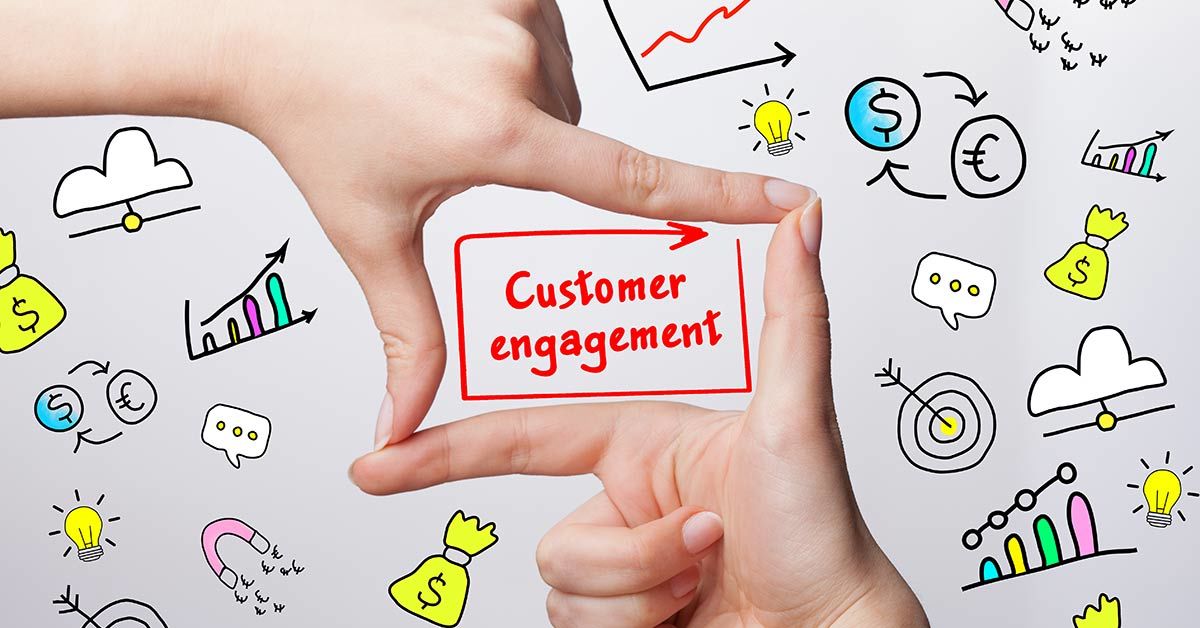Do you believe that the relationship between your business and its customers ends when they make a purchase? If so, your digital customer engagement might need a little tweaking to meet the needs of today’s modern consumers. Customers today require a lot more attention than they might have a few decades ago. People today are used to having their needs met instantaneously; doing otherwise can lead to a loss of business.
The average customer wants to have a two-way conversation and relationship with the brands they use. Customers appreciate genuine reciprocation - they buy your products and services, and you respond with a stand-out customer experience when they interact with your contact center. In many cases, customers expect those interactions to happen online since that’s where they spend a sizable amount of their time. They want to chat, send emails, and do so at the times that make the most sense for them.
So, what does that mean to you as a business? It means that reaching out to and keeping customers comes down to excellent digital customer engagement. When you understand what digital customer engagement is, how it is changing, and how to incorporate it into your brand, you’ll create more opportunities for customers to stay loyal to you.
What is digital customer engagement?
One of the first things to be aware of is that there is a difference between digital customer experience and digital customer engagement. Many people get them confused but having a grasp on the differences is critical. While the two items are related, they aren’t the same thing.
We want to talk through what makes them different, so you understand why each should have its own focus to help you succeed.
What is customer engagement? It can take a plethora of forms. Engagement might be talking to a chatbot, leaving a comment on Facebook or Instagram, replying to an email, or any other active behavior. Essentially, you want an engagement strategy that ensures that when a customer reaches out, they can interact with you on the channels that they engage with, thus building loyalty.
The digital customer experience refers to the way your customer thinks of your brand, based on their personal interactions. That means that if you have a stronger customer engagement strategy, you will deliver a better customer experience.
The reason customer engagement matters
Rather than having the power held by brands and companies as it used to be in the past, the modern world now is an environment where customers truly come first. That means relationships between customers and businesses have moved to become more than transactional exchanges.
When you want to ensure loyalty among your customers, they have to be consistently interested in what you are doing. That means keeping your clients engaged.
Based on information from Gallup, there are three types of customers when it comes to engagement:
- Actively disengaged customers. This kind of customer is completely detached emotionally from your business. Switching to a different brand is something they will do without even thinking twice about it. If you make things difficult for these customers, they are the most likely to share that with the people in their social circle.
- Indifferent customers. An indifferent customer is one who is neutral in both a rational and emotional way. This sort of customer will not have any serious concerns about either using your products or moving to another company. The feelings these customers have just aren’t serious enough for it to matter.
- Fully engaged customers. A fully engaged customer is one who is both emotionally and earnestly loyal to your company. This kind of person is going to want to have access to all of your products since they believe no other company offers the same level of quality. These customers can be considered brand ambassadors and will be the most profitable and valuable customers you have.
There is data to show that fully engaged customers will buy more from you. They will also show more loyalty to your brand, regardless of how the economy is doing. They have a deep connection to your company and will pay more to keep it that way. Strengthening customer relationships is key to building loyalty.
Fully engaged customers can provide a 23% premium on profitability, the share of wallet, relationship growth, and revenue compared to a typical customer. On the flip side of the coin, a disengaged customer is going to represent a 13% reduction in those same things, according to the same Gallup Poll referenced earlier.
Trends in modern customer engagement
Customer engagement has gone digital, and it’s unlikely to turn back. This form of engagement is constantly changing and growing, which can make it hard to keep up with the latest trends and technology coming out.
However, doing so is important to bring in new customers and ensure the ones you already have stick around. Being aware of modern trends can ensure your company’s success.
Technology is creating a revolution of big data
The digital world we live in is one where enormous amounts of information are created every day. It has only recently become possible to properly access and analyze all that information on a large scale.
Brands will find that it’s now easier to keep customers engaged by creating services and products that truly resonate with them. When you have a customer-centric brand, your products will be developed using what you know of your customer’s preferences and feedback.
Complexity isn’t the only thing that matters, however. Having real-time customer insights gives companies the option to remain agile and act upon customer expectations to remain relevant.
Companies are providing a truly holistic experience
Rather than having a single phone number, as you might have in the past, customers want to reach you on any device or channel they already frequent.
This is useful since many customers aren’t interested in digging around to get in touch with you every time they have a question or concern. Customers can simply use the channels that they prefer and are familiar with, and contact you as needed. This helps build brand loyalty and reassure customers that you will be there not just when they need you, but where they need you.
This means that the way information flows through your business is more important than ever before. The good news is that technology has made it possible to see what’s going on in any department at a glance. As an example, over 60% of failed customer support calls could be solved more easily using better access to data.
Having a single customer view lets companies handle this issue and meet the omnichannel needs of their customers. When a customer has consistent experiences, a business can collect more data, save on resources and time, and increase the chances of upselling.
The world is connecting through IoT
Not long ago, customers and brands would only communicate when a sale was occurring. This meant that a business had less insight into customer behavior, so the only form of customer engagement was reactive.
With the explosion of IoT (Internet of Things), this has completely changed. People, processes, and things can now all communicate together. For example, many devices at your home can communicate with each other by exchanging, gathering, and analyzing information.
The intersection of strong data analytics with interconnected devices has changed the way companies and customers interact forever. Business Insider predicts that there will be over 41 billion IoT devices by 2027, as compared to 8 billion in 2019.
With those items and the potential for communication between all of them, customer engagement options will be nearly endless. Imagine being able to send a push notification to a customer’s Amazon Alexa device, for example, alerting them to important information about their account or recent order. It’s not an impossible dream, considering we’re already seeing text-based push notifications on smartphones, computers, and in other forms.
Social media is building communities and personalities
With the advent and popularity of social media, companies now have platforms where they can engage in two of the most popular aspects of humanity: storytelling and community. Rather than having online one-to-one conversations, brands can have many-to-many conversations that spark interest in who they are and what they do.
Social media is one of the biggest factors in allowing companies to create personalities that their customers can feel connected with.
Many companies are focusing on using social media to their advantage by showcasing products, sharing interesting information, and talking to customers in spaces in which customers are already spending time.
People often use tools like Facebook’s Messenger to reach out to businesses and they expect a prompt, engaged, personalized response. When your engagement strategy includes social media, you’ll be ready for these customers and any others that want to communicate with you on social.
If a customer can send a Facebook message and get an answer to their question quickly, they will be far more likely to remain loyal because they are met with a response on the channel they prefer.
AI automation keeps conversations flowing
The world today is “always on.” That means that your customers want to reach you at whatever time and place is the most comfortable for them. Once they send a message your way, they also expect you to respond quickly.
About 75% of online customers expect to receive an answer within five minutes of messaging a company, according to a study by McKinsey. Another 66% believe they should receive a response in no less than 10 minutes for customer service, sales, and marketing inquiries. This would be impossible with only human agents, but AI has made this something that companies can provide with little work.
- Chatbots are seen in many places these days, from websites to social media and beyond. The right bot software, such as that offered by NICE CXone, can answer 80% of customer questions, meaning human agents can focus on the more challenging inquiries. The global chatbot market is predicted to hit $1.23 billion by 2025, according to Grandview Research. As NLP tech and machine learning improve, so will chatbots.
- Voice assistants. Besides chatbots, voice assistants are also keeping conversations flowing at all hours of the day. As of 2019, more than 111 million people in the United States were using voice assistants every month or more frequently. Many voice assistant products can respond to and understand complicated conversations, remind users of events, and make recommendations for products and places.
If you’re looking to incorporate automation into your customer engagement efforts, the best place to start is with customer service processes. Using chatbots can ensure common queries from customers are answered correctly and quickly at all times of the day. These bots can also provide recommendations in seconds.
Personalized interactions are proliferating
Now that we’re in the age of the customer, thinking of your audience as all the same won’t work. Customer engagement and communication need to be personalized to draw in customers and keep them loyal to your brand. The majority of consumers indicate that they are much more likely to engage with a branded offer if it has been personalized based on their past interactions with a company.
With rapid advances in communication tools and big data, it’s becoming increasingly challenging to ensure ultimate personalization in your communications. You can easily see this by visiting Netflix or Amazon and using their personalized recommendation engines. Personalization can, and in some instances, should, go beyond these tools: It could mean creating custom loyalty coupons for a customer’s favorite products; rendering specific website content based on a user’s interests; and more. In the future, it might not be surprising if brands have unique relationships with each of their customers.
To begin building those relationships now, you’ll want to engage as many tools and channels as you can to increase customer engagement. When developing your engagement strategy, focus on personalized contact and the best ways to deliver that to your audience. Some of the best tools to provide that personal connection include:
- Direct emails with a single interaction; no customer service trees where an email exchange comes back from a different agent every time.
- Social media messaging services, with or without integrated chatbots and AI.
- Chatbots and live chat agents on the main website.
- Omnichannel routing with intelligent technology to ensure the customer gets to the right agent at the right time for the right resolution and less shuffling around in the service queue.
Use modern trends to benefit your business
As a business, you want to use new digital customer engagement trends to stay on top of your competition. That involves remembering a few best practices:
- Stay tech-savvy. Always pick the top tools to analyze and gather data and take time to communicate with your customers.
- Keep up conversations. Be sure that you have a two-way dialogue going with customers, and encourage the use of comments, sharing, and reactions.
- Remain in real time. Your team should be capable of immediately responding to messages. Automation is a great way to be sure no customer has to wait on a response.
- Work in omnichannel mode. Having a unified customer view lets you be there for all your customers whenever and wherever they need you. This makes it easier to pick up a conversation that took place in the past.
- Be personal. Build unique experiences for your customers by using a platform thatlets you show a person that your company is aware of other interactions that you have had with them in the past.
Unique customer engagement options that fit your brand
At NICE, we know that customer engagement is changing and growing because of new technological advances. That’s precisely why we offer a bevy of solutions for companies, large and small, on an open cloud foundation. Products we offer to create better customer engagement focus on these technologies:
- Omnichannel routing solutions
- Automation and artificial intelligence
- Workforce engagement options
- Customer analytics products and services
Whether you run a small business or are an executive at a major enterprise, NICE provides solutions that will streamline your business processes and ensure your customers keep coming back. Our innovative technology lets you put customers first, so you can build and develop relationships. Learn more about our solutions and how they can help your business deliver personalized and exceptional engagement.






